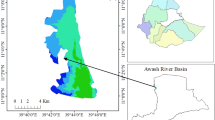Abstract
Excessive ground water withdrawal can lead to ground water depletion, and this may have serious social and economic consequences. Attempts to limit groundwater pumping have been commonly based on the concept of safe yield. In this study, in order to evaluate safe yield, short- and long-duration pumping tests have been performed at four different sites (Purulia District, India) on Damodar River bed. The lithological survey was carried out along the river bed at regular intervals from 500 m to 10.5 km, covering a total stretch of 10-km up-stream and 0.5-km down-stream, to determine the soil profile and other soil characteristics. The points, where the maximum depth of porous medium was obtained, were selected for carrying out the pumping yield tests. The appropriate hydrogeologic approaches were employed to estimate the values of aquifer parameters, viz., specific yield (S y), transmissivity(T), and hydraulic conductivity (K) for the aforesaid sites under study, which were found to be in the range of 0.043–0.175, 2082–3983, and 219–603 m/day, respectively. A hypothetical aquifer-stream water interaction system has been developed using GMS software (groundwater modeling system) not only to represent the hydraulic head fluctuations in the groundwater system around well fields but also to quantify the flow rate due to change in river stage, recharge due to rainfall, and also to determine how the surface water could affect groundwater due to pumping.










Similar content being viewed by others
References
Abu-Al-Sha’r WI, Hatamles RI (2007) Using MODFLOW and MT3D groundwater flow and transports models as a management tool for the Azraq groundwater systems. Jordan J Civ Eng 1(2):153–172
Akindunni FF, Gillham RW (1992) Unsaturated and saturated flow in response to pumping of an unconfined aquifer: numerical investigation of delayed drainage. Ground Water 30(6):873–884
Alley WM, Leake SA (2004) The journey from safe yield to sustainability. Ground Water 42(1):12–16
Banerjee G (2012) Groundwater abstraction through river-bed collector well: a case study based on geophysical and hydrologic investigation. Clean Tech Environ Policy 14:573–587
Barlow PM, Ahlfeld DP, Dickerman DC (2003) Conjunctive-management models for sustained yield of stream–aquifer systems. J Water Resour Plan Manag ASCE 129(1):35–48
Bevan MJ, Endres AL, Rudolph DL, Parkin G (2005) A field scale study of pumping-induced drainage and recovery in an unconfined aquifer. J Hydrol 315:52–70
Bhattacharjya RK, Barma SD (2009) Modeling the effect of stream flow on groundwater flow fields using GMS. J Appl Hydrol 22(3&4):172–179
Bunn MI, Rudolph DL, Endres AL, Jones JP (2011) Field observation of the response to pumping and recovery in the water table region of an unconfined aquifer. J Hydrol 403:307–320
Groundwater Modeling System 6.0 (2006), Brigham Young University, Technical Support by Environmental Modeling System, Inc., Utah, USA
Groundwater Resource Estimation Methodology (GEC) (1997) Report of the groundwater resource estimation committee. Ministry of Water Resources, Government of India, New Delhi
Kushwaha RK, Pandit MK, Goyal R (2009) MODFLOW based groundwater resource evaluation and prediction in Mendha subbasin, NE Rajasthan. J Geol Soc India 74:449–458
Maimone M (2004) Defining and managing sustainable yield. Ground Water 42(6):809–814
Maréchal JC, Vouillamoz JM, Kumar MSM, Dewandel B (2010) Estimating aquifer thickness using multiple pumping tests. Hydrogeol J 18(8):1787–1796
Moench AF (1994) Specific yield as determined by type-curve analysis of aquifer-test data. Ground Water 32(6):949–957
Neuman SP (1979) Perspective on delayed yield. Water Resour Res 15:899–908
Nwankwor GI, Cherry JA, Gillham RW (1984) A comparative study of specific yield determinations for a shallow sand aquifer. Ground Water 22:764–772
Osman YZ, Bruen MP (2002) Modeling stream–aquifer seepage in an alluvial aquifer: an improved loosing-stream package for MODFLOW. J Hydrol 264:69–86
Schwartz FW, Zhang H (2003) Fundamentals of ground water. Wiley, Hoboken, pp 219–232
Seward P, Xu Y, Brendock L (2006) Sustainable groundwater use, the capture principle, and adaptive management. Water SA 32(4):473–482
Sophocleous M (2002) Interactions between groundwater and surface water: the state of the science. Hydrogeol J 10(1):52–67
Theis CV (1940) The source of water derived from wells: essential factors controlling the response of an aquifer to development. Civ Eng 10(5):277–280
Todd DK (2010) Groundwater hydrology, Second edn. Wiley, Hoboken, pp 64–155
Valerio, AM(2008). Modeling groundwater-surface water interactions in an operational setting by linking riverware with modflow, Thesis of Master of Science, Department of Civil, Environmental, and Architectural Engineering, University of Michigan
Wang W, Li J, Feng X, Chen X, Yao K (2011) Evolution of stream–aquifer hydrologic connectedness during pumping: experiment. J Hydrol 42:401–414
Woessner WW (2000) Stream and fluvial plain ground water interactions: rescaling hydrogeologic thought. Ground Water 38(3):423–429
Acknowledgments
The project “Hydrogeologic Study of Subsurface Water Flow/Storage Characteristics for Creation of Sustainable Source on Rainfed River for SemiArid and Fluoride affected Blocks in connection with comprehensive Water Security Plan for Damodar and Kangsabati River under Purulia District” was awarded to the School of Water Resources Engineering, Jadavpur University by the Public Health Engineering Department, Govt. of West Bengal. The authors are grateful to the Public Health Engineering Department, Govt. of West Bengal for their confidence reposed on them for this type of research work. The authors gratefully acknowledge the kind cooperation and support during the field survey of this project. from the officers, PHED Purulia Division, Govt. of West Bengal and all the other staffs of PHED Purulia Division, Govt. of West Bengal.
Author information
Authors and Affiliations
Corresponding author
Rights and permissions
About this article
Cite this article
Roy, P.K., Roy, S.S., Giri, A. et al. Study of impact on surface water and groundwater around flow fields due to changes in river stage using groundwater modeling system. Clean Techn Environ Policy 17, 145–154 (2015). https://doi.org/10.1007/s10098-014-0769-9
Received:
Accepted:
Published:
Issue Date:
DOI: https://doi.org/10.1007/s10098-014-0769-9




